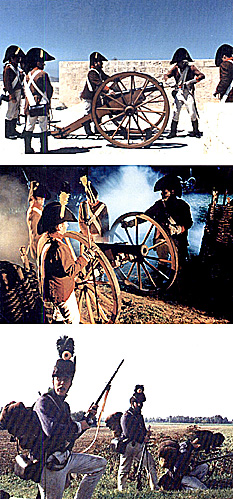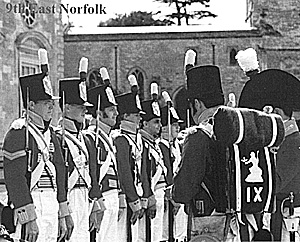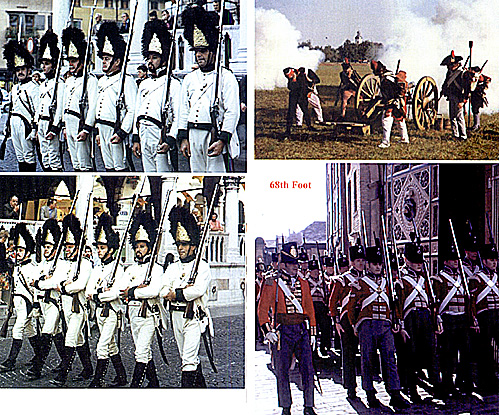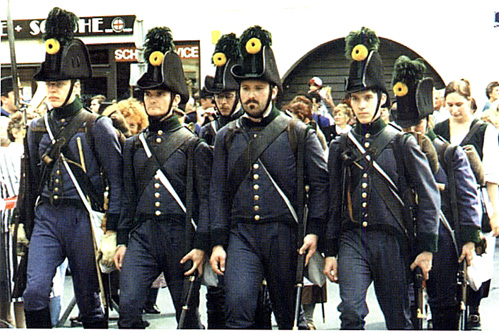A Beginner's Guide to Napoleonic Re-Enactment
Insights
by Steve Vickers
| |
Battle re-enactment as we know it today (that is the dressing up kind) really started back in the early 70's when Brigadier Peter Young formed the Sealed Knot in Britain and the English Civil War period had its first re-enactors. From these early days of dressing in nylon and wearing hush puppy type footwear, re-enactment has come on a long way. I can almost hear some of you thinking that it hasn't in all groups! Well more of that later. The first organisation (in Britain) to don Napoleonic attire was the Sabre Society in 1972 with its plastic shakos and modern shot guns. As with the nature of the beast the Sabre Society had a split and out popped the Napoleonic Association. Historically Napoleonic groups tend to be small and aligned fully to no organisation in particular. There are a few groups that buck the trend but not many. An average size for our period is no more than 15 men with muskets.
Since the early embryonic years of historic recreation many periods and styles have emerged to give us every width of the spectrum when it comes to "interpretation"! This brings us nicely onto the "what". It is a regular question asked of re-enactors by the public. Re-enactment is probably best described as "recreating an individual of X period and adopting a style of life and drill for the nationality portrayed."
Of course this is for military recreation but why go into more detail? Napoleonic battle re-enactment in Britain has one major problem which no one can argue against. There were no battles on this small island. Our fellow re-enactors in Central Europe have it all (yes, I know there were others but where did it really count?). The English Civil War re-enactors can claim Britain, the Napoleonic Wars, Central Europe. For the short period of time in which the Napoleonic wars took place we can claim more or less all of Central Europe as a battle site. Yes, and we have Bonaparte to thank for this. Those re-enactors that malign this man must remember that it is he they should thank for their hobby. We are very lucky to be alive during the 200th aniversary of every single Napoleonic engagement. For the next 15 years we have all the bicentennials to look forward to. Many small towns and villages will be remembering the days when they were an important mark in their community history and celebrating in the usual manner with street parties, concerts and the main attraction of a battle re-enactment. There is no better time than now to join in the fun and hunt down a group that suites your needs. It will be another hundred years before we see the like again.
I would guess that you would already know what nationality you would like to dress up as. If not then it will be much easier to pick a group that would suit your needs. With a bit of effort, roaming around the internet (or contacting First Empire!) you will find someone doing whatever nationality you want but it may mean joining a group who are either living in a different area or another country. This may not be a problem to you. Unfortunately individuals join groups that do not suit them and rather than hunting around leave the hobby instead. It is always a good idea to find out about a group before making any commitment or spending any money.
So, what's out there? Re-enactment groups come in two styles. Only two I hear you ask? When you rip off the skin there really are only two styles available to you. The first style recruit whole families and deny no one membership and the other type are more choosey. Ouch I felt that!
This is oversimplification to the extreme but the point I make is an important one. Life in the army was not easy. Men were tough, agile and well
basically men. To recreate a company of men in this period of history would be practically impossible. We are all too tall (on average), too well fed and do not have the same ailments that occurred giving the Napoleonic soldier this very unique appearance that can only come by enduring life during the early 19th Century.
It is just the same as wargaming and modelling. There are those armies that look good at 5 feet and there are those that are superb at 12 inches.
It usually follows that the "distance" groups are not so particular with specific detail and will generally accept cross dressing. This term has become an amusement in re-enactment over the years. It basically means women dressed up as men. Since the first few years of battle re-enactment it has been an acceptable part of the hobby and a means of getting more "soldiers" in the line but as the years have gone by it is becoming less acceptable and groups adopting this philosophy are finding it more and more difficult to find quality events. It is difficult writing in this way as I can see the sexism in it. However, if we are recreating something surely we do it to our best ability? Yes there were some women who passed themselves off as men and did it very well otherwise they would have been found out. The number however was minute. In fact the only acceptable time when a woman is dressed as a man is in pantomime, Prince Charming. Theatrically speaking that is.
The next area of choice comes in the living quarters. Re-enactments generally mean you would be camping outside in a field with only the essential amenities which you share with hundreds of others. In short, portaloos, standpipes and tents. The choice of living quarters is not a
palace or hovel but white canvas or coloured nylon (including caravans). It is becoming more and more popular now to bivoac in white canvas tents, sleeping on straw and eating food prepared around the camp fire. Even burger vans are shunned as they destroy the image of the
camp. Plastic in the camp? I think not.
Due to the nature of out door activities we normally find our re-enactments are held during the summer months. This does not follow
the bicentennial route and more events may be held during the other wet and cold periods of the year in future. As sponsors require spectators to make a show it will be the norm to have a summer season of battle re-enactment and we do need to keep busy during the periods between bi-centennials.
To finish off, our Napoleonic soldier needs to adopt specific actions and manoeuvres through drill exercises. By using Dundass for British troops and the École de Soldat for French troops our Napoleonic soldiers are replicating all the different exercises and formations that our counterparts had to practice so many times 200 years ago. The one thing letting this period down is the lack of troops. Napoleonic battles involved 100s of thousands of troops and the most we can get onto a re-enactment field at one time is usually the Waterloo event with some 5000 troops in total. To achieve this the French army includes marching bands and any group who can put together something vaguely Napoleonic. Our other problem is that the Allies are out numbered by about 5 to 1 and they are supposed to win! Don't you just love
re-enactment?
As hobbies go it is one where you can meet many new friends of all nationalities. Find a niche that suits your requirements or abilities and above all have a great time.
If you are interested in joining in the fun please contact any of the groups on these pages or contact First Empire directly. We would be only too pleased to put you in touch with one of the groups available.
|
 For those of you who may have an interest in joining a re-enactment group or just have a passing interest into the exploits of this strange hobby, I hope the following will give you an insight into what, where, how, when and why.
For those of you who may have an interest in joining a re-enactment group or just have a passing interest into the exploits of this strange hobby, I hope the following will give you an insight into what, where, how, when and why.
 Which group to choose? Well, at this point I could go into a lot of detail of how I see each group but as I have two of everything I need and none of them broken I will focus on style of interpretation rather than get into the discussion of what is good or bad. It is, afterall, you who will make a decision based on what you see and your personal preferences.
Which group to choose? Well, at this point I could go into a lot of detail of how I see each group but as I have two of everything I need and none of them broken I will focus on style of interpretation rather than get into the discussion of what is good or bad. It is, afterall, you who will make a decision based on what you see and your personal preferences.
 So, when you look at re-enactment groups generally with a critical eye you would just turn away and say that is just themed camping or even worse, pantomime. However, no group can replicate exactly the illusion so we have to do something. The choice is one of the following;
So, when you look at re-enactment groups generally with a critical eye you would just turn away and say that is just themed camping or even worse, pantomime. However, no group can replicate exactly the illusion so we have to do something. The choice is one of the following;
 Over the years the uniforms have improved dramatically and all uniforms are made of 100% wool. In fact a great many uniforms are made using Abimelich Hainsworth fabrics in Yorkshire. Even in the fashion capital of the world, Milan, the re-enactment tailors use Hainsworth's fabric. Some keen individuals even make a living out of manufacturing for re-enacters. There are leather workers, tailors and gun manufacturers all assisting the hobby by supplying everything we need to recreate our full size Napoleonic soldier. Many improvements in uniforms have come
from some very hard work by researchers who focus on specific items of clothing or equipment. We applaud their efforts.
Over the years the uniforms have improved dramatically and all uniforms are made of 100% wool. In fact a great many uniforms are made using Abimelich Hainsworth fabrics in Yorkshire. Even in the fashion capital of the world, Milan, the re-enactment tailors use Hainsworth's fabric. Some keen individuals even make a living out of manufacturing for re-enacters. There are leather workers, tailors and gun manufacturers all assisting the hobby by supplying everything we need to recreate our full size Napoleonic soldier. Many improvements in uniforms have come
from some very hard work by researchers who focus on specific items of clothing or equipment. We applaud their efforts.